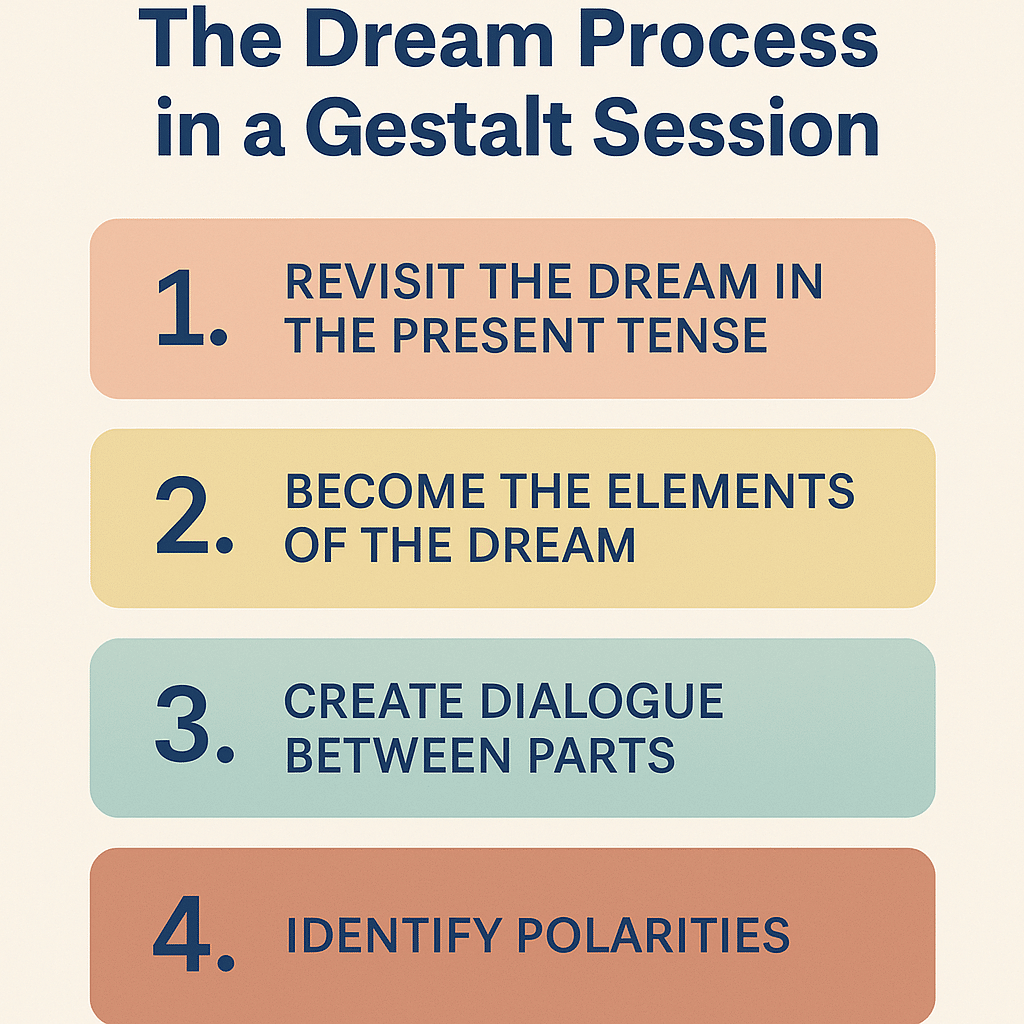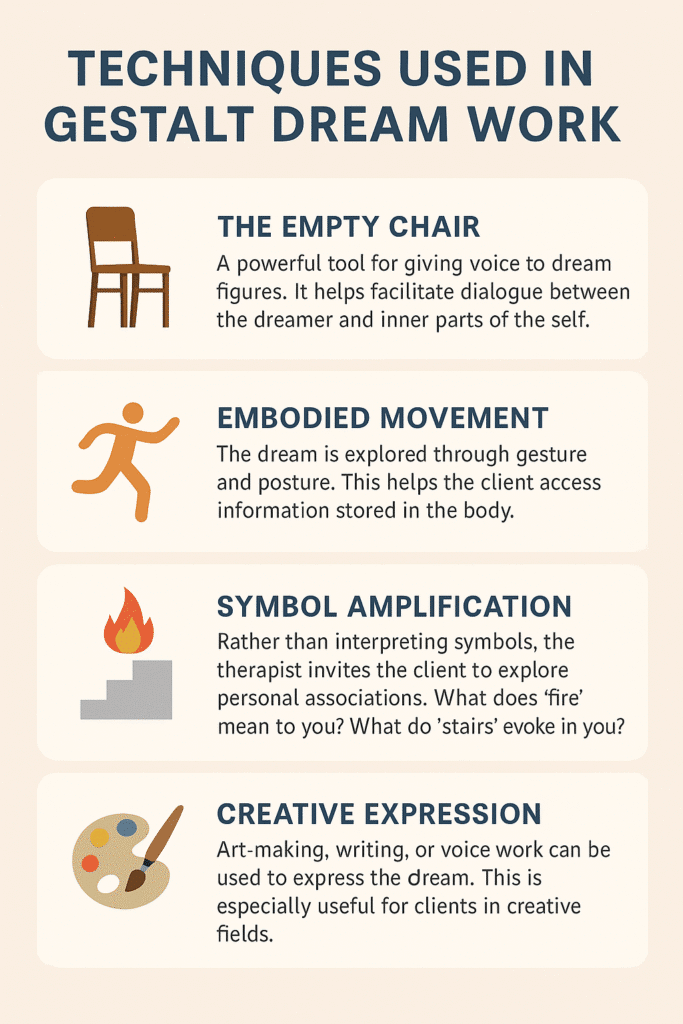
You wake from a dream feeling unsettled. You remember only fragments … a staircase that leads nowhere, an old friend whose face you haven’t seen in years, a glowing object just out of reach. The dream lingers like fog, leaving you with the distinct sense that it meant something, even if you can’t quite say what.
In a place like California, where emotional intelligence and personal growth are woven into the cultural fabric, many people are drawn to explore the deeper layers of their psyche. For some, dreams are simply strange nighttime stories. But for others, they hold meaning, insight, and transformation.
Gestalt therapy offers a powerful way to engage with dreams – not by interpreting them from the outside, but by stepping into them from within. Rather than relying on symbolic dictionaries or fixed meanings, Gestalt dream work invites you to re-enter your dream and explore it experientially. The goal is not to explain the dream but to integrate it.
For Bay Area clients seeking something deeper than analysis, Gestalt dream work provides a creative and embodied path to insight. It’s a process that is intuitive, emotionally rich, and often surprisingly direct.

Why Work With Dreams?
Dreams are spontaneous messages from your unconscious. They often bypass the filters of logic and bring forward truths that your waking mind may avoid or repress. This makes them a vital source of information, especially for those who feel stuck or disconnected from their emotions.
Unlike traditional approaches that decode symbols through interpretation, Gestalt therapy views every element of a dream as a projection of the self. A tree, a stranger, a locked door—each part of the dream is seen as a part of you.
This is where Gestalt dream work becomes uniquely powerful. It doesn’t treat the dream as something to solve. It treats it as something to experience.
The Gestalt Approach to Dream Work
Fritz Perls, the founder of Gestalt therapy, believed that dreams are rich with existential truth. He encouraged clients to explore dreams as if they were happening right now, not then or later.
In Gestalt, the dream is not a puzzle to crack. It is a living, breathing expression of your internal world. By working directly with dream images, sensations, and roles, you can make contact with unconscious aspects of your identity that are trying to come into awareness.
This approach is especially well suited to clients in the Bay Area, where people often seek a more embodied, holistic, and integrative approach to therapy.
The Dream Process in a Gestalt Session
1. Revisit the Dream in the Present Tense
The therapist might ask you to describe the dream as if it is happening now. This brings the experience to life and reactivates the emotional charge of the dream.
“I am walking down a narrow hallway. I see flickering lights. I feel a sense of dread.”
Speaking in the present moment deepens your contact with the experience and helps access parts of yourself that may be outside conscious awareness.
2. Become the Elements of the Dream
You are invited to take on the role of different parts of the dream. This might include characters, objects, even the setting.
“I am the hallway. I am long and dark. I feel like I’m holding something secret.”
“I am the shadow. I want to be noticed. I want to be understood.”
Each element is approached as if it were alive, with its own voice, intention, and meaning. Often, this reveals aspects of the self that have been disowned or ignored.
3. Create Dialogue Between Parts
Using the empty chair technique, you engage in a dialogue between yourself and one or more parts of the dream.
From your chair: “Why are you chasing me?”
As the dream figure: “Because you keep running from what you already know.”
This back-and-forth allows conflicting or split-off aspects of the self to communicate, creating space for integration.
4. Identify Polarities
Gestalt dream work often reveals internal polarities—parts of the self that are in conflict. The confident speaker versus the hidden child. The achiever versus the exhausted body.
Rather than eliminating one or the other, the goal is to hold both parts in awareness. In doing so, you begin to reclaim your full range of experience.
Why It Works So Well in California
In a state known for innovation, creativity, and depth psychology, it’s no surprise that dream work resonates here. California’s culture supports exploration of inner worlds. People are more open to non-linear processes, to metaphors, to emotion, to embodiment.
In the Bay Area especially, high achievers and intellectuals often find themselves longing for something more intuitive and soulful. Gestalt dream work gives them a way back to that part of themselves.
It also speaks to artists, spiritual seekers, activists, and people going through major life transitions. Dreams offer them a non-verbal, emotionally alive way to explore what’s next.
A Sample Dream Process
“I’m on a boat in the middle of a storm. My partner is on shore, calling to me. I can’t reach them.”
In therapy, we might:
- Re-enter the dream: “I am on the boat. The waves are rising. I feel helpless.”
- Become the boat: “I’m holding you, but I’m fragile. I can’t keep you steady.”
- Become the storm: “I’m here to shake things up. You’ve been ignoring something.”
- Dialogue with the partner: “Why are you on the shore?” “Because you left me emotionally.”
The dream unfolds into a deeper understanding of the client’s fear of vulnerability and emotional distance in their relationship. But the insight doesn’t come from the therapist—it comes from the dreamer’s own embodied experience.
Techniques Used in Gestalt Dream Work
The Empty Chair Technique
This classic Gestalt tool becomes especially dynamic in dream work. After identifying a key figure from the dream—a person, animal, object, or abstract force—the client places it in an empty chair across from them. The client then engages in dialogue, moving between chairs to speak as both themselves and the dream figure.
The process allows suppressed or fragmented parts of the psyche to speak. A frightening shadow in a dream might reveal itself to be a protector. A passive bystander might express hidden resentment or wisdom. Through dialogue, clients externalize inner conflicts, express unspoken emotions, and reclaim disowned traits.
This method is especially powerful for clients who tend to intellectualize. By embodying the dream figure and speaking from its perspective, they drop into direct emotional and psychological experience rather than analyzing from a distance.
Embodied Movement
In Gestalt therapy, the body is seen as a carrier of implicit memory and emotional truth. Exploring a dream through movement brings it alive in the body and helps bypass intellectual defenses. Instead of just talking about a snake in the dream, the client becomes the snake—moving, hissing, curling, sensing.
This technique may include posture shifts, gestures, breath changes, vocal tones, or full-body movement. What does it feel like to be the collapsing bridge? What happens in your body when you stretch your arms like wings?
Embodied dream work taps into preverbal experience. It helps the client connect with sensations and emotions that may not yet have words. This is especially helpful for clients healing from trauma, or those who feel disconnected from their bodies due to chronic anxiety, perfectionism, or overidentification with intellect.
Symbol Amplification
Gestalt dream work avoids assigning fixed meanings to symbols. Instead, it invites the client to stay curious and amplifythe personal resonance of a dream image.
If a client dreams of fire, the therapist might ask:
- “What is fire to you?”
- “What memories or feelings come up when you think about fire?”
- “If fire had a voice, what would it say?”
The client might respond with associations ranging from danger and destruction to passion and vitality. The symbol becomes a mirror for multiple facets of self—some conscious, others emerging.
Amplification is not about extracting one definitive meaning. It’s about exploring the emotional and imaginal terrain a symbol opens up, and how it relates to the client’s lived experience, values, or challenges.
Creative Expression
Dreams speak in the language of metaphor and image—making them especially responsive to creative processes. Gestalt therapy welcomes the use of art, writing, sound, and other expressive modalities as a way to deepen and externalize dream exploration.
Clients may be invited to:
- Draw or paint a key image from the dream
- Write a letter from one dream character to another
- Sculpt a shape that captures a recurring dream theme
- Create a soundscape or vocal tone to represent the dream mood
These expressive acts allow clients to process the dream on multiple levels—visual, somatic, emotional, and symbolic. This is particularly resonant for California clients working in creative industries or spiritual communities, where metaphor, expression, and embodiment are already valued.
Creative expression can also serve as a bridge between sessions, offering clients tangible artifacts to return to as they integrate the dream’s wisdom into waking life.
How Dreams Lead to Change
Dreams often point toward unmet needs, unresolved emotions, or neglected desires. In therapy, they may reveal:
- A need for rest or restoration
- Grief that hasn’t been acknowledged
- An inner child who feels unseen
- A fear of change or loss
- A desire for freedom or authenticity
Rather than interpreting these needs intellectually, Gestalt dream work allows the client to experience them directly and develop a new relationship with those parts.
This leads to change not by fixing or solving—but by fully meeting what is.
Who Can Benefit from Dream Work
You don’t need to have nightmares or recurring dreams to benefit from this process. Gestalt dream work is especially helpful if:
- You’re in transition or feeling stuck
- You’ve been relying on intellect over emotion
- You’re experiencing anxiety or confusion
- You feel disconnected from creativity or purpose
- You want to access deeper layers of self-awareness
Finding a Dream Therapist in the Bay Area
Many therapists in San Francisco, Oakland, Berkeley, and surrounding areas offer Gestalt dream integration. Whether you’re in a high-pressure career or on a healing journey, dream work can help you connect to your emotional truth.
At Center for Mindful Therapy, some of our therapists offer:
- Personalized Gestalt dream sessions
- Embodied and creative approaches to inner work
- Culturally attuned care for diverse identities
- Integration of mindfulness and somatic practices
We help you explore the landscape of your dreams not to interpret you—but to help you know yourself more deeply.
Your Dreams Are Speaking. Are You Listening?
When explored through Gestalt therapy, your dreams become more than nighttime stories. They become doorways—into your hidden feelings, forgotten wisdom, and untapped potential.
You don’t need to analyze them. You don’t need to figure them out. You just need to be willing to feel, to listen, and to show up.
Dreams invite you to become more fully yourself.
If you’re ready to begin that journey, we’re here to walk beside you. Browse our California therapist directory or contact us to today find a Gestalt therapist who can help in exploring your dreams.




